







Dating back to the 16th century, this historic building now houses one of the administrative departments of the City of Fribourg. With a surface area of 1800m2, its gas-fired heating system has been optimized by YORD since the 2022-2023 heating season.

Our installer installed the optimization system in just one day. This involved installing the controller, communication gateway and sensors in the building.

Automatic optimization of the heating system has improved thermal comfort in winter. Significant savings were also achieved over two heating periods, thanks to our system’s increasingly precise knowledge of the building.
Our system adapts to your new installation. Our team will transfer the solution to your new heating system.
A new building can also be made more efficient by optimizing its heating system. In addition to structural work and the often more efficient insulation of a recent building, optimization enables temperature monitoring and ensures thermal comfort while saving energy.
The sensors send their data to the communication gateway using the LoRaWAN protocol. The advantages of this radio frequency protocol are its long range, low data rate and secure use.
Installation is carried out by a professional and takes an average of 1 day for a building of less than 4’000m2, and 2 days between 4’000 and 10’000m2. Beforehand, a preliminary visit will be made by a member of our team to inspect the installation and its specific features to guarantee feasibility.
Savings are calculated using the heating curve and the data measured once the optimizer has been installed. We use the heating curve to determine how the heater would have reacted at a given temperature. Savings are calculated by comparing the actual data of the YORD-equipped heater with the data that would have been obtained without optimization.
Data is secured at our Swiss service provider Exoscale in Lausanne. We are aware of the critical nature of your data, and do our utmost to secure it in compliance with Swiss and European regulations. We use the LoraWan protocol instead of WiFi. We are on a local network dedicated to our system. There is no possible porosity with your computer networks within the building.
It takes a few days to model the building, understand its inertia and build the default heating curve for the boiler within our system. Once the optimizer has properly integrated the building’s thermal envelope, the algorithms are able to anticipate heating requirements and make savings while maintaining comfort.